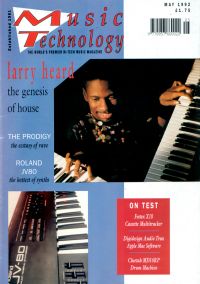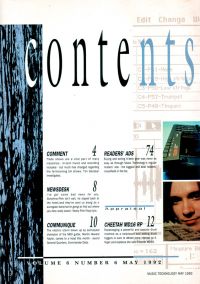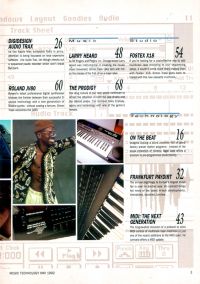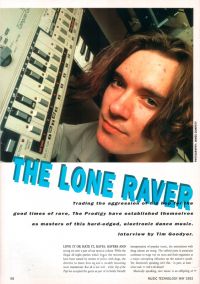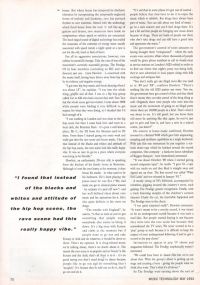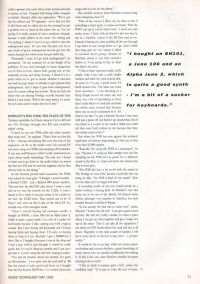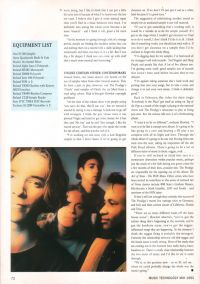Articles
The Prodigy related articles from magazines.
The Music Technology Magazine
The Lone Raver
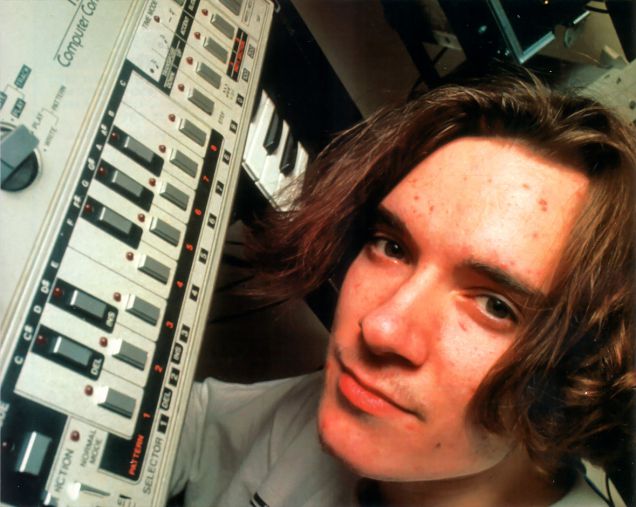
The drug culture of the rave scene continues to attract the attention of both the pop charts and the tabloid press. Tim Goodyer talks Ecstasy, agony and technology with one of the genre's heroes.
Trading the aggression of hip hop for the good times of rave, The Prodigy have established themselves as masters of this hard-edged, electronic dance music.
Love it or hate it, raves, ravers and raving are now a part of our musical culture. While the illegal all-night parties which began the movement have been tamed by armies of police with dogs, the directive to dance lives on and is steadily becoming more mainstream. But all is not well - while Top of the Pops has accepted the genre as part of its family-friendly interpretation of popular music, the associations with drug culture are strong. The tabloid press in particular continues to wage war on raves and their organisers as a major corrupting influence on the nation's youth. Yet, historically speaking, isn't this - in part, at least - what rock 'n' roll is all about?
Musically speaking, rave music is an offspring of house. But where house has tempered its rhythmic obsession by incorporating the temporarily-neglected forms of melody and harmony, rave has pursued rhythm to new extremes. Armed with the technology which freed house from the rock 'n' roll line-up of guitars and drums, rave musicians have made no compromises where speed or subtlety are concerned. The hard-edged sound of digital technology has availed the musicians of the extremes of energy more usually associated with speed metal; a night spent at a rave is not for the old, tired or faint of heart.
For all its aggressive associations, however, rave culture is essentially benign. Take the case of one of the movement's currently successful groups, The Prodigy. Of its four members (including an MC and two dancers) just one - Liam Howlett - is concerned with the music itself, having been driven away from hip hop by its violence and negative energy.
"I got into hip hop music and break dancing when I was about 13", he explains. "I was into the whole thing, graffiti and all that. I was in a hip hop group called Cut to Kill who had a record deal with Tam Tam but the whole scene got too violent. Come about 1988 white people were finding it very difficult to get respect for what they were doing, so I decided that I'd had enough of it.
"I was working in London and was close to the hip hop scene but then I came back here and went to a local club, the Braintree Barn - it's quite a well-known place, Mr C, the DJ from the Shamen used to DJ there. From there I started going out every week and really got into the rave scene and house music. I found that instead of the blacks and whites and attitude of the hip hop scene, the rave scene had this really happy vibe. It was so nice to go to a place where everyone was trying to be friendly."
Howlett, an enthusiastic 20-year old, is speaking from the kitchen of his family home in Braintree. Although it's not his own home at the moment, it does house his studio - in what used to be his bedroom. He's been playing the piano since he was five ("My dad made me go to classical piano lessons - he reckons it's paid off now") and has well-defined ideas about rave music and his aspirations for it. He's also quite definite in his views on drugs.
"The trouble with England", he asserts, "is that as soon as you've got something that people enjoy, somebody else wants to bring it down. It's a big issue with Ecstasy and clubs at the moment but if people want to go out and take Ecstasy or Acid and do whatever, it should be down to them. That's my opinion. It is drug-related music we're talking about, there's no doubt about it. The reason the rave scene is so popular and so 'buzzy' is the Ecstasy and the Acid; that's all there is to it - it's no good saying you don't need drugs to dance because people like to go out and do something that's 'naughty'. It's because they're told not to do it, they'll go out and do it.
"It's sad that in some places it's got out of control - people believe that they have to do it to enjoy the music which is rubbish. But drugs have always been part of music. You can talk about any kind of music - go to a rock concert and you'll find drugs there. It's just a bit sad that people are bringing rave music down because of drugs. There are loads of people out there who don't take drugs and can still have a good time and appreciate the music."
The government's control of raves amounts to having brought them "overground" - where the early events were secretive affairs where thousands of people would be given phone numbers to call or would meet at service stations on London's M25 orbital in order to to find out where that night's party was being held, they're now advertised in local papers along with folk evenings and antiques fairs.
"You don't really get any illegal raves like you used to in '89 and '88", confirms Howlett. "There's nothing like the old M25 parties any more. You see, the government have got control of that and they think that it means they can take control of the drug thing as well. Originally there were people who were into the music and the excitement of going to an illegal party' where there are 10,000 people in a field. That's what it was about to me. It's still good, but you know there will never be anything like that again. So you've just got to grin and bear it, and have a rave in a school centre, you know?"
His interest in house music confirmed, Howlett invested in a Roland W30 which gave him sequencing, sampling and synthesis capabilities in a single keyboard. With just this one instrument he put together a ten-track demo tape which he hawked around the record companies. One company - a hardcore dance subsidiary of Beggars Banquet - were immediately interested.
"It was about October '89 when I started giving record companies tapes", he recalls. "I gave XL a tape with ten tracks on and they liked it straight away and signed me up then. The first record was called 'What Evil Lurks' and was released in January '91."
A steady string of EPs followed, accompanied by relentless gigging around the country's raves, each gaining The Prodigy greater recognition. Finally, with a track featuring samples of the children's cartoon character Charly the cat, the inevitable happened and The Prodigy were in the charts.
"I was quite surprised really", Howlett comments. "It wasn't meant to be a novelty record, it was meant to be an underground record because it was such a mad idea. But people started buying it not because they were into the rave scene but because they remembered the TV series. We never wanted to be a 'pop' group as such because it is difficult to keep the respect of your underground following if you've got a record in the pop charts."
Invitations to appear in pop TV shows and magazines followed. The Prodigy emphatically weren't interested.
"We could have been in Smash Hits but we're not about that. What the group's about is getting up on stage and creating a buzz - giving the people what we think they want. That's what it's all about."
"I found that instead of the blacks and whites and attitude of the hip hop scene, the rave scene had this really happy vibe."
So The Prodigy were turning down the sort of public exposure that costs other artists serious amounts of money to buy. Charged with being either arrogant or foolish, Howlett offers his explanation: "We've got this far without any TV exposure - we've had two hits in the charts and no other rave act has managed to get a position two or three in the charts like us. I'm not saying I'm really proud of chart positions though, because I really believe in the music I'm writing and I'm putting it where I want it to go, which is into the underground scene. It's just that this past year we've seen loads of good underground records get into the charts, because the whole scene has got really big.
"Personally I hope it'll go back underground", he comments. "At the moment it's at the height of its publicity. If you look through so many magazines you'll find articles about kids going out at the weekends raving and doing Ecstasy. I think it's at a point where we've got to decide whether it becomes out-and-out pop music or whether it gets pushed back underground. And I hope it goes back underground, even if it means selling less records. There are kids out there who are buying Prodigy records because they think it's pop music. Well it isn't pop music; it's music for our scene and it's music that we're into."
Howlett's W30 took the place of the Technics turntables he'd been using in Cut to Kill and saw The Prodigy through two EPs and countless nights' raving.
"I used to run one W30 while the other loaded, then swap over", he explains. "That's how we first did it live - mixing and playing bits over the top of the sequences. As far as the studio went, the second EP was done using two W30s and sampling off turntables. It was easy stuff because I didn't really understand too much about studio technology. The only way I found to learn was to go down to the studio where we mixed the first two EPs and sit with the engineer and let him tell me what he was doing."
As the formula proved itself successful, the W30s were joined by more gear: "I bought a sound module - a Roland U220 - and a Roland 909 drum machine. That was how the third EP came about: I wrote a track just to try out the sounds on the U220, it wasn't meant to be a track, it was just meant to be a demo to see how the U220 went. That turned out to be 'G Force' and went on the b-side of the third EP. It's actually one of the strongest tracks.
"Then I started buying old analogue synths. I bought an SH101, a Juno 106 and an Alpha Juno 2, which is quite a good synth. I'm a bit of a sucker for keyboards because I like coming out with original sounds. But I love buying old keyboards and I'll keep buying them and buying them. I'll carry on buying them as long as I can. Recently I got a JD800 but I don't like it. I bought it because it was in the shop and I had a play with it and thought it would be really good, but I've had it about six months and I just can't get into it. I prefer using the old 'real' analogue synths.
"I've had the Bassline about two months. It's quite an old machine - I was quite into the acid stuff in '88 but the sound is really good and heavy so I bought that and the Kenton MIDI box. I've written about two songs with it so far for the album."
One notable omission from Howlett's current setup is the ubiquitous Atari ST.
"One of the reasons I don't use an Atari is that if something is hand-made, it comes out better. With the W30 I can tap in exactly what I want - I never use copy mode, never. I think with an Atari it's just too easy to tap in a bassline, repeat it for 30 bars and so on. Instead of having the same cymbals all the way through I tap them in and change them as I go. And I think that helps give me 'my' sound. I talked to another local group, Shades of Rhythm, about it and they couldn't believe it. I was going to buy an Atari but there's no point.
"I like to keep sequences really, really simple. Like I may take a really simple bassline and build the track around that. As soon as I've got a good hook I'll build around that. The ideas can come from anywhere - I was listening to a Deep Purple record the other day and there was a bit of drumming in there that I really liked so I took that and built the whole track around that because there was so much excitement in it. It's hard to say that I've got a formula because I may start with just a piano riff and build it up around that. But if you listen to a couple of my tracks I think you could tell they were both written by me because they have this similar construction."
But where the W30 has won against the technical superiority of software sequencing, it's lost out to that of an Akai S1100 sampler.
"Basically I'm using the W30 as a sequencer", he says, "because I'm using an Akai sampler now and the sampling on the W30 isn't as good. It's a different sound to the Akai, it's closer and more raw whereas the Akai is more pure.
"The W30 did have a lot to do with the sound of The Prodigy to start with, because everybody else was using an Akai. The W30 is kind of 'my sound'. Now I've the Akai and I'm happy with that."
A recording studio of any sort would hardly be a studio without a mixing desk. In Howlett's case this turns out to be one of the Mackie 16-channel desks which, although very popular in America, has only recently become available in Britain.
"It was actually the first one to come over", claims Howlett. "It does the job well - I can get a good sound up here. But this isn't really a studio, it's more a place where I can get my ideas together and get a rough mix up on the mixer. Then I can take all the equipment I use down to CWS Studio down the road and mix it all down. Hopefully in the next couple of months I will have some kind of decent setup here - a proper studio."
"I bought an SH101, a Juno 106 and an Alpha Juno 2, which is quite a good synth - I'm a bit of a sucker for keyboards."
It would be fair to say that, while rave music majors on rhythms and counter rhythms, a great knowledge of music theory isn't an essential qualification for making it. If this is the case, does Howlett consider his piano training to be an asset?
"I like to think it matters quite a lot", comes the confident reply. "It is easy to write the sort of music we're doing, but I like to think that I can put a little bit extra into it because of what I've learnt over the last ten years. I believe that I give it more musical input than you'll find in a basic hardcore rave track. I'm definitely into seeing the whole scene become a lot more 'musical' - and I think it will, given a bit more time.
"At the moment it's going through a bit of a strange period, people are finding the maddest noises they can and putting them on a record with a really kicking beat underneath and there you have it, it's a hit. But if you dig a bit deeper I think you can come up with stuff that's much more musical and interesting."
Unlike certain other contemporary musical forms, rave music doesn't rely heavily on the use of samples taken from other musical sources. They do have a part to play, however, and The Prodigy's 'Charly' used samples of Charly the cat lifted from a road safety advert. Had it brought Howlett copyright problems?
"At the time of the release there were people saying 'you can't do that, they'll sue you', but we turned it around by saying it was a message to kids not to go off with strangers. I think the guy whose voice it was phoned Virgin and tried to get some money for it but they said 'No way' and he said 'Fair enough, I like the record anyway'. That was the guy who spoke the words for the advert, and that was the end of it.
"I'm working on one tune with a Led Zeppelin sample in that I don't know if we're going to get clearance on. If we don't I'll just put it out as a white label because it's a good tune."
The suggestion of substituting another sound or sample for an uncleared sample is not well received.
"If you've got something that's working well, it would be a mistake to re-do the sample yourself. If I got to the stage where I couldn't get clearance so I had to re-do it myself, I don't think I'd do it at all. I think that if something works, you should just stick with it. If you don't get clearance on a sample then I'd be inclined to forget the whole thing.
"I'm digging deep for my samples. I've borrowed all my manager's old rock records - Ted Nugent and Deep Purple and people like that. A lot of live albums too. I'm getting some really good samples out of records that haven't been used before because, they're too obscure.
"I'm against taking someone else's hard work and putting that into your songs, but to take a noise and change it to suit your own music, I think is definitely good."
Back in February, the video for their single 'Everybody in the Place' got itself an airing on Top of the Pops as a result of the single's placing in the national charts and The Prodigy's reluctance to play at being pop stars. But the serious talk now is of a forthcoming album.
"I want it to be so different", enthuses Howlett. "I want it to be like a concept rave album. It's going to be like going to a rave and hearing a DJ play a set complete with all its highs and lows. Through the whole album it's going to be one mix flowing from one track into the next, taking my inspiration off the old Pink Floyd albums. There's going to be a lot of different styles of music in there: reggae, rock...
EQUIPMENT LIST
- Akai S1100 Sampler
- Alesis Quadraverb Multi-fx Unit
- Mackie 16-channel Mixer
- Roland Alpha Juno 2 Polysynth
- Roland SH101 Monosvnth
- Roland JD800 Polysynth
- Roland Juno 106
- Polysynth Roland W30 (x 2)
- Roland TB303 Bassline with Kenton MIDI Interface
- Roland TR909 Rhythm Composer
- Roland U220 Sample Reader
- Sony DTC 750ES DAT Recorder
- Technics SL1200 Turntables (x 2)
If you're still inclined to think that rave is a momentary aberration within popular music, perhaps just the result of a few kids having too good a time for a few months of their lives, consider this: The Prodigy are responsible for the opening cut of the album The Art of Noise - The FON Mixes. Other artists who have been invited to contribute to this series of remixed Art of Noise classics include 808 State's Graham Massey, Rhythmatic's Mark Gamble, LFO and Youth - and members of the FON team.
If that's still not enough then consider the success of The Prodigy's recent live outings visits to Germany, and Italy and their current circuit of California, Florida and Texas.
"There are so many different roads off the basic house scene", Howlett observes, "you've got the techno thing that's happening at the moment, you've got the hardcore scene, you've got the reggae-influenced songs that are happening. At the moment I think the reggae thing is probably the strongest. Certainly the relationship between old dub reggae and the house scene is really strong. Most of the tracks that are coming out at the moment have really heavy, heavy basslines on. There's a really close relationship between the two styles of music and I'd like to see it come through.
Scans
Categories
- Articles front page 85
- Australian articles 21
- Austrian articles 3
- Canadian articles 11
- Chinese articles 1
- Czech articles 3
- Danish articles 5
- English articles 269
- Finnish articles 25
- French articles 3
- German articles 22
- Greek articles 2
- Hungarian articles 5
- Icelandic articles 11
- Indian articles 4
- Irish articles 10
- Israil articles 1
- Japanese articles 27
- New Zealand articles 5
- Norwegian articles 11
- Polish articles 4
- Russian articles 17
- Scottish articles 8
- Serbian articles 1
- Singapore articles 1
- South African articles 4
- Spanish articles 8
- Swedish articles 4
- Turkish articles 1
- UAE articles 1
- US articles 78
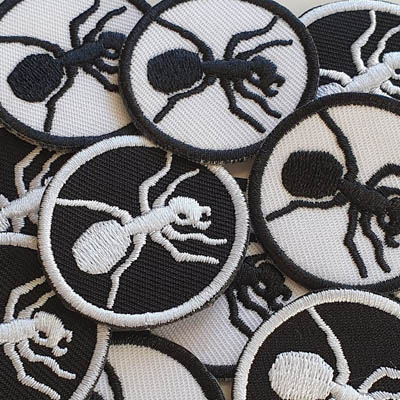
Trending
31 Dec 2011 Sabotage Times
The Prodigy Interviewed: “No more snorting cheap speed and banging pills up my arse”
06 Sep 2019 Music Business Worldwide
Peermusic UK signs the Prodigy’s Maxim Reality to exclusive global publishing deal
02 Nov 2017 South China Morning Post
Liam Howlett of The Prodigy on ‘fake controversy’, the band’s fired-up frontman Flint and new ‘old’ album ahead of Clockenflap
01 Aug 1992 Mix Mag
Did Charly Kill Rave?
30 Jul 2019 MusicTech magazine
Prodigy engineer/co-producer Neil Mclellan remembers the Jilted Generation sessions
The Prodigy 34 pcs sticker set
Big set of The Prodigy stickers. 17 different designs (2 of each) and total of 30 stickers. Sticker sizes vary from 9 cm to 3,5 cm. Order here >
